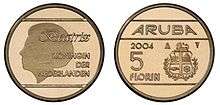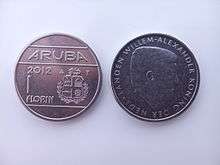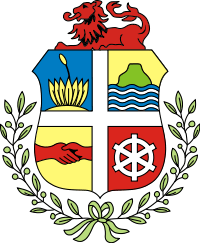Aruban florin
| Aruban florin | |
|---|---|
| Arubaanse florijn (Dutch) | |
| ISO 4217 | |
| Code | AWG |
| Denominations | |
| Subunit | |
| 1⁄100 | cent |
| Plural | florin |
| cent | cent |
| Symbol | Afl.[1] |
| Banknotes | 10, 25, 50, 100, 500 florin |
| Coins | 5, 10, 25, 50 cent, 1, 5 florin |
| Demographics | |
| User(s) |
|
| Issuance | |
| Central bank | Central Bank of Aruba |
| Website |
www |
| Printer | Joh. Enschedé |
| Website |
www |
| Valuation | |
| Inflation | 4.4% (2011)[2] |
| Method | CPI |
| Pegged with | U.S. dollar = 1.79 florin |
The florin (sign: Afl.; code: AWG) is the currency of Aruba. It is subdivided into 100 cents. The florin was introduced in 1986, replacing the Netherlands Antillean guilder at par. Although the Aruban florin is pegged with 1.79 US$, the commonly used street value is at 1.75 US$.
Coins
In 1986, coins were introduced in denominations of 5, 10, 25 and 50 cents, 1 and 2 1⁄2 florin. Later, the 5 florin banknote was replaced by a square coin and the 2 1⁄2 florin coin was removed from circulation. The 5 florin was later on in 2005 replaced with a round golden coin, because the old square 5 florin coin was too easy to counterfeit. All coins are struck in nickel-bonded steel with exception of the 5 florin, which is an alloy of copper and other metals. The 50 cent is the only square-shaped coin remaining, also commonly referred to as a "yotin" by the locals.
On the back of each 1, 2 1⁄2 and 5 florin coins is the profile view of the current head of state of the Kingdom of the Netherlands. From 1986 till 2013 it was queen Beatrix and from 2014 onwards it is king Willem-Alexander. Moreover, only these coins have a writing on their edge, 'God Zij Met Ons' meaning 'God Be With Us'.



Banknotes
The Central Bank of Aruba introduced banknotes in denominations of 5, 10, 25, 50 and 100 florin and dated January 1, 1986.[3] In 1990, the bank issued the same denominations in a colorful new family of notes designed by Aruban artist Evelino Fingal. As director of the Archaeological Museum, Fingal found inspiration in old Indian paintings and pot shards. Fingal combined decorative motives found on pre-Columbian pottery with pictures of animals unique to the island. The 500-florin notes were introduced in 1993, with the 5-florin note replaced by a square coin in 1995.
As of 2003 a new print was started of the then already existing banknotes of 10, 25, 50, 100 and 500 florin. These new banknotes were made with new safety features to counteract counterfeiting, but retained their look.[4][5]
| Image | Value | Main Colour | Depicted Animal | |||
|---|---|---|---|---|---|---|
| Obverse | Reverse | |||||
 |
 |
10 AWG | Light Blue | Conch | ||
 |
 |
25 AWG | Orange | Rattle Snake | ||
 |
 |
50 AWG | Red | Burrowing Owl | ||
 |
 |
100 AWG | Green | Frog | ||
 |
 |
500 AWG | Dark Blue | Red Grouper | ||
Current exchange rates
| Current AWG exchange rates | |
|---|---|
| From Google Finance: | AUD CAD CHF EUR GBP HKD JPY USD |
| From Yahoo! Finance: | AUD CAD CHF EUR GBP HKD JPY USD |
| From XE: | AUD CAD CHF EUR GBP HKD JPY USD |
| From OANDA: | AUD CAD CHF EUR GBP HKD JPY USD |
| From fxtop.com: | AUD CAD CHF EUR GBP HKD JPY USD |
See also
Notes
- ↑ "The International Organization for Standardization (ISO) uses the abbreviation 'AWG' as the currency code for Aruba. However, Aruban law uses the abbreviation 'Afl.' for the Aruban florin." Centrale Bank van Aruba, Glossary
- ↑ Centrale Bank van Aruba, Annual Statistical Digest 2011
- ↑ Linzmayer, Owen (26 April 2011). "Aruba". The Banknote Book (1st ed.). San Francisco. p. 7.
- ↑ Centrale Bank van Aruba (8 October 2015). "Banknotes and Coins".
- ↑ Centrale Bank van Aruba (8 October 2015). "Banknotes and Coins - Security Features".
External links
- Krause, Chester L.; Clifford Mishler (1991). Standard Catalog of World Coins: 1801–1991 (18th ed.). Krause Publications. ISBN 0873411501.
- Pick, Albert (1994). Standard Catalog of World Paper Money: General Issues. Colin R. Bruce II and Neil Shafer (editors) (7th ed.). Krause Publications. ISBN 0-87341-207-9.
